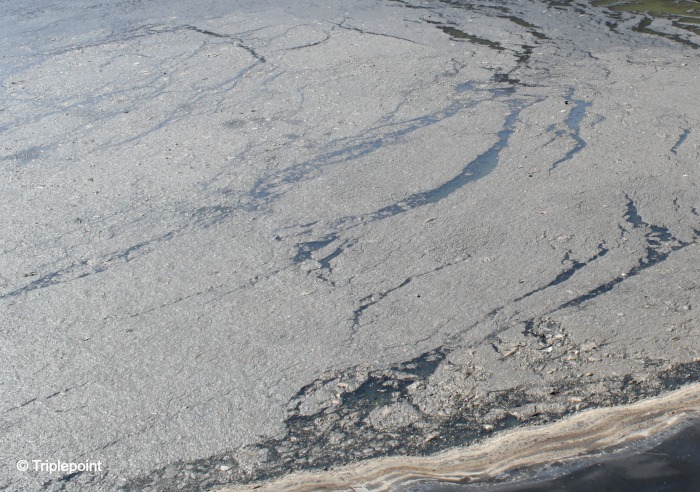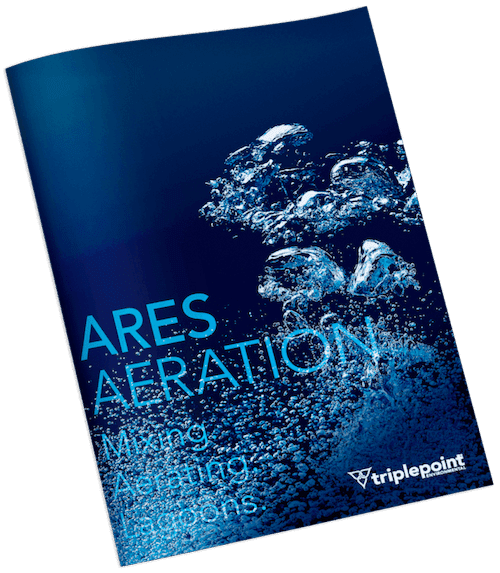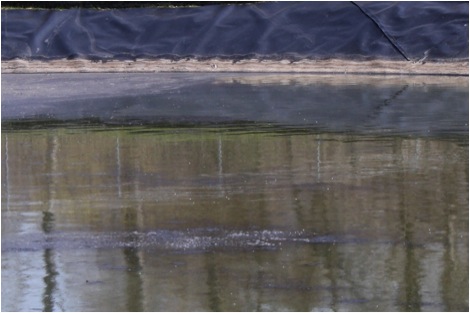
Spring is the time of the year when unmixed lagoons turn over, so it’s also the time of the year when operators (and local residents) are concerned about wastewater lagoon odor control. Although spring lagoon turnover and its accompanying odors may be normal and expected, that doesn’t mean they are tolerated. Learn what causes lagoons to turn over and what can be done to mitigate odor.
What causes lagoon turnover?
An unmixed wastewater lagoon will settle into layers, with denser, cooler water at the bottom and lighter, warmer water at the top. This is known as thermal stratification. In spring and fall, the change in ambient temperatures causes the layers to mix and eventually create a uniform temperature. As the layers begin to destratify and mix, the settled solids become resuspended and the odorous gases trapped at the bottom are released to the surface, a phenomenon called lagoon turnover. In a healthy, functional lagoon, this process should take about a week. In a well aerated and mixed lagoon, it won’t happen at all.
What makes spring turnover and odors so severe?
Spring is usually the time of highest BOD loads in a wastewater lagoon. You’ve got the BOD that’s been stored over the winter, new influent BOD, and the BOD demands of the accumulated sludge at the bottom of the lagoon.
In the spring, increased sunlight warms the top layer of the lagoon, melting the surface ice and allowing sunlight to penetrate, creating convection currents. Gradually, with the sun’s warmth and wind, the entire lagoon reaches a uniform temperature and circulation increases.

This increased circulation disturbs the accumulated sludge and solids that have been lurking at the bottom of the lagoon, and pushes them to the surface. This releases hydrogen sulfide (H2S), the stinky gas that is generated by anaerobic digestion.
The dislodging of the settled sludge and solids also results in benthal feedback or benthal release, which is when nutrients like nitrogen and inorganic materials like metals that have been trapped in the sludge get released back into the lagoon. Benthal feedback can cause ammonia levels in the lagoon to be higher than in the influent.
Once the temperature hits 50°F or so, bacterial action begins in earnest and starts to consume all the BOD that’s been stored up over the winter. The problem is, aerobic BOD-eating bacteria need dissolved oxygen to work, and there just isn’t enough. In the spring, a wastewater lagoon can need as much as triple the usual amount of DO—as much as 5–6 lbs. of O2 per pound of influent BOD—to handle the increased load.
Problems Caused by Lagoon Turnover
Without sufficient DO, the bacteria resort to anaerobic digestion, which is a slow and smelly process. Sludge accumulates, odors linger, and effluent violations from undertreatment are likely:
- Floating sludge: As the increasing sunlight and wind circulate the water, the solids settled at the bottom, which have been quietly anaerobically digesting, are churned up. The anaerobic digestion process releases gas as a byproduct, which becomes entrained in the sludge. Once dislodged, the gas trapped in the sludge causes it to rise from the bottom of the lagoon and float. For more on this topic, visit our dedicated Solutions page on sludge.
- Intense Odors: With the rising gas byproduct of anaerobic digestion, unpleasant lagoon odors are released into the atmosphere all at once. These odors, coupled with those of the floating sludge mat, are strong during lagoon turnover. If picked up by the wind, these odors will likely result in angry calls and a feature story in your local newspaper.
- Lagoon Treatment Suffers: Lagoon turnover can be a sign that your lagoon is septic and is breaking down nutrients via anaerobic digestion. Expect a spike in effluent BOD, TSS, and other treatment parameters at some point in the near future if corrective action is not taken.
How to Prevent Spring Lagoon Odors
To prevent lagoon turnover you need to combat the causes:
- Increase circulation to prevent stratification: By continually circulating the water, the lagoon layers will never be able to fully stratify. With both a homogeneous lagoon water temperature and environment, no spring lagoon turnover will occur.
- Increase dissolved oxygen levels to combat low DO: One of the easiest ways to do this is to add aeration to your lagoon. By maintaining an aerobic environment you will limit the production of noxious H2S gases.
- Increase mixing to prevent sludge buildup on the bottom: Proper lagoon mixing limits sludge accumulation by keeping solids in the water column where they can break down aerobically and odor-free.
Mixing is a critical component of wastewater lagoon aeration, keeping oxygen distributed throughout the water column and preventing solids from settling as sludge. Watch our Wastewater Lagoon Mixing Case Study video and see how Triplepoint’s lagoon aerator, which combines efficient fine bubble aeration with coarse bubble mixing in a single portable unit, eliminated floating sludge and odors.

Download the Ares Aeration brochure.
Emergency Wastewater Lagoon Odor Control
Proper aeration and mixing will prevent future odor events, but what if you have an odor problem right now? Triplepoint offers turnkey aeration rental systems that can be on site within days. As a temporary solution, deodorizing sprays or lagoon additives like Aquafix’s DAZZeL ECO PLUS, an essential oil-based odor neutralizer, can help. Once temperatures and DO levels have stabilized, the odors should subside.

